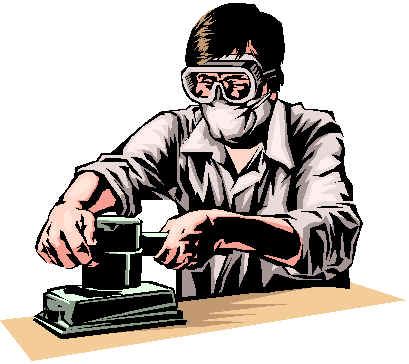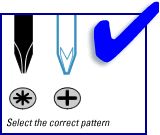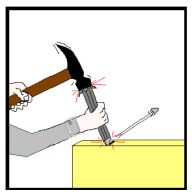| Page 2 |

|
|
1 - Tool & Machine Guard
2 - Page 2 3 - Page 3 |


Screwdrivers:
  |
Most screwdrivers are not designed to be used on electrical equipment. Use an insulated screwdriver.
Do not hold an object in the palm of one hand and press a screwdriver into it, place it on a bench or a table.
Never hammer with a screwdriver.
Check for broken handles, bent blade, etc.
Pliers
 |
Do not use pliers as a substitute for hammers or wrenches.
Use insulated pliers when doing electrical work.
Inspect installation frequently to make certain that it is free of breaks or cracks.
Hammers
 |
Use the correct hammer for the type of work to be done.
Have an unobstructed swing when using a hammer and watch for overhead interference.
Check for defects before using.
Wrenches
 |
Select the correct size of wrench for the job.
Never use a pipe wrench as a wrench handle extension.
Too much leverage can ruin a tool and cause injury.
To avoid sudden slips stand in a balanced position and always pull on the wrench instead of pushing against the fixed jaw.
Chisels:
 |
Always wear safety goggles or a face shield when using a chisel.
Drive wood chisel outward and away from your body.
Do not use chisels to pry.
Keep edges sharp for most effective work and protect when not in use.
Knives:
 |
Always cut away from the body.
Keep hands and body clear of the knife stroke.
Keep blades sharp.
Portable Electric Equipment:
 |
Do not raise or lower equipment using the cord.
Do not use staples to fasten a cord.
Do not damage the equipment's casing or the cord insulation.
Inspect before use and check for external and internal defects.
Remove damaged equipment from service, attach a do not use; sign, and give to your supervisor.
Guards shall be used on all hand and power tools that are designed to accommodate such guards.
Ladders:
 |
- Place a ladder at an angle so the horizontal distance between the foot of the ladder and the support where it has been placed is not more than one-quarter the length of the ladder from the top point of support to its base.
- Do not place ladders in front of doors unless the door is blocked open or locked.
- Use a barrier and place warning signs conspicuously to prevent people from walking into the ladder.
- Ladders should extend 3 feet above the top of the roof contact area.
| << Previous 1 [2] 3 Next >> |

